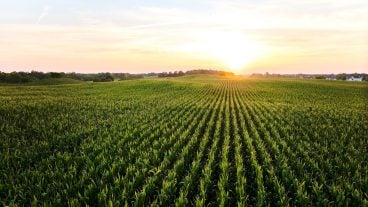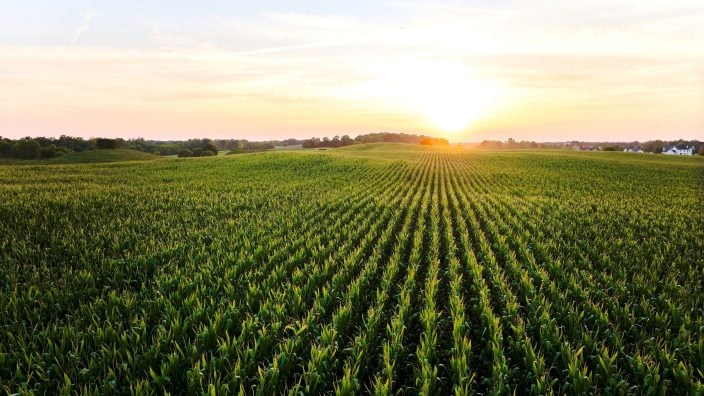Farmer’s Guide to Trucking Regulations available to Ohio Farm Bureau members
The guide includes a farm driver checklist, overview of state and federal regulations and exemptions, CDL qualifications and more.
Read More
This has been another one of those years.
Local farmers are frustrated and anxious because they have not been able to get their corn or soybeans planted. Just when fields begin to look like they may be getting dry, along comes another rainy period. So the tillage tools and planter have to stay in the shed another few days and farmers wonder if or when they will be able to get them out again.
Not only has it been wet but soil temperatures have not been good enough for seed germination. They need to be around 50 to 55 degrees for the seeds to start to sprout.
How important are corn and soybeans in Trumbull County? According to the most recent National Agricultural Statistical Service 2016 estimates, Trumbull County farmers harvested 20,000 acres of corn in 2016. The total yield for those acres was 2.97 million bushels.
The 20,000 or more acres are a lot of ground to still get planted. Some experts say May 20 is an optimal date to get the seed in the ground. Anything after that can result in lower yields. Adjustments may have to be made by planting shorter season varieties that result in lower yields.
But the land is available and farmers want to get it planted if they are going to have any income at all. So they will work night and day to get crops in the ground, even though yields may not be what they would like.
NASS estimates for 2016 indicate that 26,000 acres of soybeans were planted in the county. Years ago, there were no soybeans planted in Trumbull County and now they have become an important economic crop. Those acres yielded more than 1.76 million bushels.
Some of those acres were planted to food grade soybeans that are for export, mostly to Japan. Food grade beans have to be handled carefully during the harvesting process. The Japanese are particular about both quality and packaging.
The window for planting soybeans is somewhat longer than for corn, but for good yields they need to be planted soon.
It is hard to describe how frustrating it can be when you are ready to get in the field and get corn and soybeans planted. You are ready but then it rains and stays cooler than you like. So you have to wait a few more days, then decide what adjustments you may have to make to get crops planted that will be able to mature before frost next fall.
Many farms have been tiled to improve the drainage and allow the fields to be worked earlier. Installing drain tile is an expensive operation but does pay off in the long run if fields are to be planted.
Trumbull County years ago was not a grain growing county. In the 1930s, 40s and 50s, it was a dairy county with dairy farms up and down most roads. There were a number of excellent, progressive dairy farmers who had cows making top production records.
In 2016, NASS estimated there were just 2,900 milk cows in the county, which ranked 25th in Ohio. Most of the herds left have good producing cows and they are efficient in the overall operations or they would not be in business.
But now the county is largely a grain growing county, a big change from 50 or 60 years ago. Grain growing makes them very dependent on the uncertainties of the weather. Let’s hope that, at this point, there will be some planting weather that allows farmers to get our on the land and get those corn or soybeans planted — soon.
Submitted by John Parker is an independent writer for the Tribune and local Farm Bureau.
OFBF Mission: Working together for Ohio farmers to advance agriculture and strengthen our communities.


The guide includes a farm driver checklist, overview of state and federal regulations and exemptions, CDL qualifications and more.
Read More


Ohio Farm Bureau provides opportunities, platforms and resources to help you develop your voice in the industry and give farmers a seat at the table with leaders and legislators.
Read More

The emergency fuel waiver to allow the sale of summer gasoline blends containing 15% ethanol will lengthen the period during which Americans can continue buying E15 from June 1 to Sept. 15.
Read More

The Small-Scale Food Business Guide covers federal and state regulations for selling food products such as raw meat, dairy, eggs, baked goods, cottage foods, fruits and vegetables, honey and more.
Read More

New resources and technology are broadening the different types of sales tools and strategies available to farmers.
Read More

ODA will enroll 500,000 acres into the program for a two-week sign-up period, beginning April 22, 2024, through May 6, 2024. Contact local SWCD offices to apply.
Read More

Katie Share of Columbus has been named ExploreAg and Youth Development Specialist for Ohio Farm Bureau.
Read More

Mary Klopfenstein of Delphos has been named Young Ag Professional and Ag Literacy Program Specialist for Ohio Farm Bureau.
Read More

The plan has been updated to give sole proprietors access to more rate stability and a smart solution that offers potential savings on health care.
Read More

The American Farm Bureau Federation, in partnership with Farm Credit, is seeking entrepreneurs to apply online by June 15 for the 2025 Farm Bureau Ag Innovation Challenge.
Read More